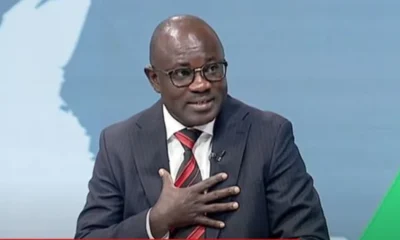World News
Unemployment Claims Show Continued Pressure on Economy: Live Updates
Published
6 years agoon
[ad_1]

As rising coronavirus cases pushed some states to reverse course and reimpose shutdown orders on businesses, 1.3 million workers filed new claims for state unemployment benefits last week, the government reported on Thursday.
The number of new claims has been declining since early April, but the weekly total is still far above records from previous downturns.
Another one million new claims were filed last week under the federal Pandemic Unemployment Assistance program, which is designed to funnel jobless benefits to freelancers, self-employed and other workers normally ineligible for state unemployment insurance.
Hiring nationwide has picked up in recent weeks, and the overall jobless rate dipped in June to 11.1 percent from a peak of 14.7 percent in April. But most of the payroll gains were because of the rehiring of workers temporarily laid off. The pool of workers whose previous jobs have disappeared and who must search for new ones has grown.
“Their circumstances may be more challenging to rectify than those who were laid off because of a temporary closure,” said Elizabeth Akers, who was a staff economist with the Council of Economic Advisers under President George W. Bush. “Finding new jobs will be more difficult. There’s been scarring in the economy.” — Patricia Cohen

Emergency government assistance in the form of expanded jobless benefits and loans to small businesses has been critical in keeping the economy afloat, said Lisa D. Cook, a professor of economics and international relations at Michigan State University. But she worries what will happen when expanded jobless benefits expire at the end of this month and other assistance programs dry up.
“At the heart of this is job loss,” said Ms. Cook, who testified before a congressional committee this week. State and local governments are laying off health care and education workers, eviction bans are expiring even though a significant chunk of household renters and businesses are having trouble making payments.
“I just worry about this all piling up in the system,” she said, “and if we don’t have an eye on it right now, we can wind up with something worse than 2008.”
Airlines announced this week that they could lay off or furlough tens of thousands of employees in October despite billions of dollars in government aid because air travel has not rebounded. And even in cities where the coronavirus caseload has declined, consumers continue to significantly cut back on their shopping and dining out. — Patricia Cohen

Although new state unemployment claims fell slightly last week, the number of people filing for benefits under the federal Pandemic Unemployment Assistance rose, topping one million for the first time since May.
Factoring in those filings, total new unemployment claims were essentially flat last week, and have edged up from their mid-June lows.
Congress created the emergency program in mid-March in order to extend benefits to independent contractors, self-employed workers and others who don’t qualify for regular state unemployment insurance. The effort got off to a slow start: Many states struggled to roll out the program at the same time they were dealing with a record number of regular unemployment claims. Jobless workers across the country reported encountering jammed websites, lost paperwork and confusing or contradictory instructions.
Those issues have spilled into the data itself. Processing backlogs, data-entry errors and other issues have made it hard to know how many people are receiving benefits under the program, or exactly when their claims were first filed. At least some states appear to be counting the same recipients multiple times.
But economists say there is little doubt that the program is now helping millions of workers who would ordinarily fall through the cracks of the unemployment safety net. More than 10 million people have filed claims under the program, which is set to expire at the end of the year. — Ben Casselman

With millions of Americans out of work because of the coronavirus pandemic, recent data from employment sites points to the split between temporary and permanent layoffs. At ZipRecruiter, for instance, the number of new jobs posted declined last week for the fourth week in a row.
“Recent jobs reports are encouraging, but the increase in employment entirely reflects rehires of workers on temporary layoff,” said Julia Pollak, ZipRecruiter’s labor economist. “The recovery in new hiring has yet to begin.”
Quirks in counting combined with a winnowing of backlogged jobless claims may artificially inflate the total number of individuals who are out of work. The June unemployment report showed 15 million fewer jobs than in February. A Labor Department report on Thursday showed that 18 million people were collecting state unemployment insurance the week ending June 27.
Further muddying the picture last week were the Fourth of July holiday and a four-day workweek, which may have held down the total number of claims.
Any way you look at it, though, the damage to the nation’s labor market is still staggering, and improvements in the economy have been tepid and uneven. The Organization for Economic Cooperation and Development said this week high unemployment would probably persist in the United States and other developed countries at least until 2022. — Patricia Cohen

More than 117,000 people filed for unemployment benefits in Texas last week, a jump of more than 20,000 from a week earlier. It was the second straight weekly increase and the highest number of new filings since late May, although still below the peak in early April.
Economists are watching Texas closely because it is one of several states where a jump in coronavirus cases has led to a new round of business closings and other restrictions. A wide range of indicators recently have suggested that the economic rebound is losing momentum in states where virus cases are rising quickly.
Thursday’s unemployment data didn’t paint a clear picture, however. New filings fell in Oklahoma, Florida and other virus hot spots, and rose only slightly in Arizona. Claims rose in New Jersey and New York, states where the virus is comparatively under control. And economists caution against reading too much into week-to-week changes in state filings, which can be volatile. — Ben Casselman
Mecklenburg Paint Company in Charlotte, N.C., is one of the businesses that have been able to rehire workers temporarily laid off because of the coronavirus pandemic.
The spring paint season was just starting up when coronavirus hit, said Liz Etheredge, the chief executive of Mecklenburg, a family business started more than three decades ago by her late husband.
“Oh, gosh, things just pretty much stopped,” said Ms. Etheredge, whose company also handles property management.
She helped most of her 30 employees apply for unemployment benefits, which she said was time-consuming and confusing. “One day I waited on hold for three hours to reach somebody” with the state to work out glitches with benefit applications, she said, “and then another day I waited two hours.”
She applied for a federal Paycheck Protection Program loan, hoping to avoid permanently laying off painters.
“It came just in time,” said Ms. Etheredge, who was able to avoid using up her savings.
She has put everyone back on the payroll, paying for it with her loan money, so she expects the entire amount will be forgiven.
“I just worry how this country is going to pay it all back,” she said. — Patricia Cohen
Stocks fell on Thursday, along with energy prices, as investors turned their focus to the risks to the economy from the coronavirus pandemic.
The S&P 500 was about 1.5 percent lower by late morning. Oil prices fell more than 3 percent after data showed stockpiles of crude in the U.S. continued to rise last week, and shares of energy producers were among the worst performing stocks in the stock market.
Also faring poorly were banks, which tumbled following a Bloomberg News report that Wells Fargo is preparing to cut thousands of jobs later this year. Retailers, meanwhile, were lower after Walgreens Boots Alliance said that it would cut about 4,000 positions at its Boots pharmacy in Britain.
Although investors have seemed to largely shrug off a rise in coronavirus cases in the United States — the S&P 500 is up nearly 6 percent since the May 25 Memorial Day holiday — worry about the virus and restrictions that are being reimposed as a result has made trading more volatile lately.
And investors continue to wrestle with new data on the state of the economy.
On Thursday, filings for state unemployment claims came in lower than expected for last week. Labor Department data showed that 1.3 million people sought benefits last week, which is lower than the 1.37 million expected by economists and below last week’s 1.43 million.
Although new claims in the Labor Department’s tally have been declining since early April, the weekly total has not dropped below a million since the coronavirus pandemic started — levels that are far above previous records.
Technology stocks again fared better than the broader market, after the German tech giant SAP gained after it reported that revenues and operating profit slowly rose in the second quarter. SAP, a software maker, said software license revenue, a main source of income, “recovered more than expected” in the quarter. Operating profit increased by 7 percent.
Technology stocks have been leading the market rally lately, because they’re seen as beneficiaries of changes brought on by the coronavirus pandemic — with more people working from home and shopping online. They’re also well insulated from the economic downturn because of large stockpiles of cash.
On Wednesday, Apple, Microsoft, Amazon and Facebook all hit records. — Kevin Granville and Mohammed Hadi
-
Boots, a large British drug store chain, said Thursday that it planned to lay off more than 4,000 people, about 7 percent of its work force, as it closed optician stores and reorganized its head office. Last quarter, sales for Boots UK dropped 27.7 percent. Also, John Lewis, a British retailer, said it would permanently close eight department stores, leaving 42 stores and putting 1,300 jobs at risk.
-
Sur La Table, the upscale cookware company, filed for Chapter 11 bankruptcy on Wednesday. In court filings, the company said it expected to sell more than half of its locations to Fortress Investment Group, and would also shutter 51 of its 121 U.S. stores.
-
Bed Bath & Beyond said on Wednesday that it would permanently close 200 stores over the next two years, starting later this year, as it tries to weather the coronavirus pandemic. The retailer said sales plunged by almost 50 percent in the last quarter despite a surge in online sales.

When you’re essentially confined to your house for weeks, you have a lot of time to think.
Paul B. Brown, in an essay for The Times, says that after thinking most about the health and safety of his friends and family, he found himself obsessing about his own finances: Like so many others, he had a big problem.
As a freelance writer, he says, he lost most of his income virtually overnight, putting him in the same situation as tens of millions of people whose paychecks vanished.
Because he followed the financial advice he’s reported on for years, he wasn’t in terrible shape, he says, with an emergency fund and a respectable portion of his portfolio in medium-term bond mutual funds, which held up well while the stock market plummeted.
But now he has resolved to learn from this crisis and do some major tweaking of his finances. Among his resolutions: Keeping more cash on hand, working harder to reduce debt, making a plan on how to use his Social Security payments, and trying to save more.

United Airlines and American Airlines said they would suspend flights to Hong Kong after the authorities there said that they would test all airline workers for the coronavirus starting on Wednesday.
Airline crew members were previously exempt from the mandatory deep-throat saliva tests that nearly everyone entering the Chinese territory must take. A cargo pilot tested positive for the virus last week.
United said in an emailed statement late Wednesday that flights to and from Hong Kong will be suspended “through July 10” because of “recent changes in testing protocol” at the city’s airport. Earlier this week, United said it planned to bring back services between Chicago and Hong Kong in September.
American Airlines, which has suspended flights to Hong Kong since the end of January, was set to restart services from Dallas to the city on Thursday. But the carrier has now pushed back the resumption of passenger services to early August. “We consider a range of factors including travel restrictions or entry requirements in making network decisions,” the airline said late Wednesday. — Elaine Yu
[ad_2]
Source link
Comments
You may like

Residents Accuse CDF Officials of KSh 2,000 Bursary Bribes – MP Zaheer Jhanda Under Fire in Nyaribari Chache

Roads in Kitutu, Colleges in South Mugirango, Rice and Beans in Nyaribari Chache: Is This MP Zaheer Jhanda’s Version of Development?

Son of Siaya or Son of Busia? David Ochieng’s Politics of Convenience Exposed

Exposing the Scandals of James Orengo in Siaya and Lands Ministry

Exposing the Scandals of James Orengo in Siaya and Lands Ministry

Son of Siaya or Son of Busia? David Ochieng’s Politics of Convenience Exposed

Roads in Kitutu, Colleges in South Mugirango, Rice and Beans in Nyaribari Chache: Is This MP Zaheer Jhanda’s Version of Development?

Residents Accuse CDF Officials of KSh 2,000 Bursary Bribes – MP Zaheer Jhanda Under Fire in Nyaribari Chache

Wantam Protests Hit Ugunja as CS Opiyo Wandayi Loses Support, Youths Invite DCP Led by Rigathi Gachagua

South Sudan at the Brink: How Corruption Tightens Its Grip on a Rare Working Institution

Chepterit Comes Alive During SportyBet Kenya Gifts Motorbike to Loyal Fans

Nest Lounge Narok Under Scrutiny as KRG The Don Shooting Incident Triggers Government Silence and Maasai Community Outcry

Why the Sh323.8 Billion Kenya US Health Agreement Is Raising Data Privacy Questions

Betty Bayo’s Mother Seeks DPP Inquest Over Daughter’s Death
Trending
-

 General News1 week ago
General News1 week agoResidents Accuse CDF Officials of KSh 2,000 Bursary Bribes – MP Zaheer Jhanda Under Fire in Nyaribari Chache
-

 General News4 days ago
General News4 days agoRoads in Kitutu, Colleges in South Mugirango, Rice and Beans in Nyaribari Chache: Is This MP Zaheer Jhanda’s Version of Development?
-

 Politics4 days ago
Politics4 days agoSon of Siaya or Son of Busia? David Ochieng’s Politics of Convenience Exposed
-

 General News2 days ago
General News2 days agoExposing the Scandals of James Orengo in Siaya and Lands Ministry
